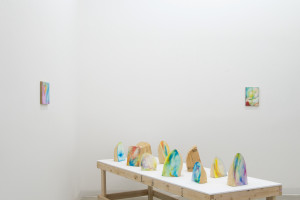Our distance from the object of desire is always measured. In Paul Donald’s new work, “Endymion Project,” the measuring is done with great nuance in his rethinking of the relationship between desire, power and the white male subject. The artist has literally and conceptually “laid bare” his body and his body of work in a series of objects and live performance that activate—and complicate—our gaze.

Paul Donald, Endymion Project, performance, January 9, 2016. Image courtesy of CB1 Gallery/Paul Redmond Photography.
Donald’s installation consists of a dozen geode-shaped objects in wood and acrylic, two small, acrylic on plywood paintings and a wooden wall and bench constructed from unfinished 2 x 4s. The wall and bench were the setting for Donald’s 40-minute performance, which consisted of the artist simultaneously revealing and masquerading his naked body by carefully applying a fine layer of TV paint stick, “in the lightest color for Caucasian skin they had,” before falling into a pose mimicking Sleeping Endymion. This 1756 painting, by Nicolas Guy Brenet of an idealized male nude in a pastoral landscape, is one of many Endymion paintings referenced in Donald’s compelling examination of this myth of desire. The verso of the performance wall is papered with Xeroxes of Donald’s Endymion sources, a reveal that is both casual and conceptual—a rare combination characteristic of this New Zealand-born artist. Donald’s process and “suite of objects” are deeply thoughtful, but don’t smack us up the side of the head with a forced brilliance. They allow us to measure the distance in our own time and to consider the dynamics of power and desire from where we stand as viewers.
The varied poses of the sleeping Endymions surface again in Donald’s painted, wooden objects. Close inspection reveals faint, erotic figures scratched into the flat surface of the headstone-shaped works. “The art of Scrimshaw was a reference point,” the artist states, but Donald’s subtle mixing of magenta, yellow and blue, layered and rubbed over the incised Endymions are a dreamy distance from black on ivory of Scrimshaw. We are drawn into these small, luminous cloudscapes where the figure is almost hidden, a welcome distance from the self-congratulatory grandiosity of so much contemporary art. “A thing of beauty is a joy forever,” Keats began his lengthy poem, Endymion. Donald’s work, “neither an apology or heroic,” reminds us that nothing is forever and everything is vulnerable.

Paul Donald, Endymion Project, performance, January 9, 2016. Image courtesy of CB1 Gallery/Paul Redmond Photography.
Paul Donald, “Endymion Project,” January 9 – February 20, 2016 at CB1 Gallery, 1923 S. Santa Fe Ave., Los Angeles, CA 90021, www.cb1gallery.com.



